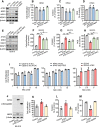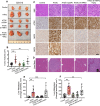ATDC binds to KEAP1 to drive NRF2-mediated tumorigenesis and chemoresistance in pancreatic cancer
- PMID: 33446568
- PMCID: PMC7849366
- DOI: 10.1101/gad.344184.120
ATDC binds to KEAP1 to drive NRF2-mediated tumorigenesis and chemoresistance in pancreatic cancer
Abstract
Pancreatic ductal adenocarcinoma is a lethal disease characterized by late diagnosis, propensity for early metastasis and resistance to chemotherapy. Little is known about the mechanisms that drive innate therapeutic resistance in pancreatic cancer. The ataxia-telangiectasia group D-associated gene (ATDC) is overexpressed in pancreatic cancer and promotes tumor growth and metastasis. Our study reveals that increased ATDC levels protect cancer cells from reactive oxygen species (ROS) via stabilization of nuclear factor erythroid 2-related factor 2 (NRF2). Mechanistically, ATDC binds to Kelch-like ECH-associated protein 1 (KEAP1), the principal regulator of NRF2 degradation, and thereby prevents degradation of NRF2 resulting in activation of a NRF2-dependent transcriptional program, reduced intracellular ROS and enhanced chemoresistance. Our findings define a novel role of ATDC in regulating redox balance and chemotherapeutic resistance by modulating NRF2 activity.
Keywords: ATDC (Trim29); chemotherapeutic resistance; pancreatic cancer; tumor growth and invasion.
© 2021 Purohit et al.; Published by Cold Spring Harbor Laboratory Press.
Figures






Similar articles
-
aPKCι promotes gallbladder cancer tumorigenesis and gemcitabine resistance by competing with Nrf2 for binding to Keap1.Redox Biol. 2019 Apr;22:101149. doi: 10.1016/j.redox.2019.101149. Epub 2019 Feb 21. Redox Biol. 2019. PMID: 30822690 Free PMC article.
-
ATDC is required for the initiation of KRAS-induced pancreatic tumorigenesis.Genes Dev. 2019 Jun 1;33(11-12):641-655. doi: 10.1101/gad.323303.118. Epub 2019 May 2. Genes Dev. 2019. PMID: 31048544 Free PMC article.
-
iASPP Is an Antioxidative Factor and Drives Cancer Growth and Drug Resistance by Competing with Nrf2 for Keap1 Binding.Cancer Cell. 2017 Nov 13;32(5):561-573.e6. doi: 10.1016/j.ccell.2017.09.008. Epub 2017 Oct 12. Cancer Cell. 2017. PMID: 29033244
-
Dual roles and therapeutic potential of Keap1-Nrf2 pathway in pancreatic cancer: a systematic review.Cell Commun Signal. 2019 Sep 11;17(1):121. doi: 10.1186/s12964-019-0435-2. Cell Commun Signal. 2019. PMID: 31511020 Free PMC article.
-
Inhibition of the NRF2/KEAP1 Axis: A Promising Therapeutic Strategy to Alter Redox Balance of Cancer Cells.Antioxid Redox Signal. 2021 Jun 20;34(18):1428-1483. doi: 10.1089/ars.2020.8146. Epub 2021 Feb 19. Antioxid Redox Signal. 2021. PMID: 33403898 Review.
Cited by
-
TRIM29 in Cutaneous Squamous Cell Carcinoma.Front Med (Lausanne). 2021 Dec 20;8:804166. doi: 10.3389/fmed.2021.804166. eCollection 2021. Front Med (Lausanne). 2021. PMID: 34988104 Free PMC article. Review.
-
AMPK-Mediated Phosphorylation of Nrf2 at S374/S408/S433 Favors Its βTrCP2-Mediated Degradation in KEAP1-Deficient Cells.Antioxidants (Basel). 2023 Aug 9;12(8):1586. doi: 10.3390/antiox12081586. Antioxidants (Basel). 2023. PMID: 37627580 Free PMC article.
-
O-GlcNAcylation of TRIM29 and OGT translation forms a feedback loop to promote adaptive response of PDAC cells to glucose deficiency.Cell Oncol (Dordr). 2024 Jun;47(3):1025-1041. doi: 10.1007/s13402-023-00915-5. Epub 2024 Feb 12. Cell Oncol (Dordr). 2024. PMID: 38345749
-
How to deal with frenemy NRF2: Targeting NRF2 for chemoprevention and cancer therapy.J Food Drug Anal. 2023 Aug 31;31(3):387-407. doi: 10.38212/2224-6614.3463. J Food Drug Anal. 2023. PMID: 39666284 Free PMC article. Review.
-
Intricate confrontation: Research progress and application potential of TRIM family proteins in tumor immune escape.J Adv Res. 2023 Dec;54:147-179. doi: 10.1016/j.jare.2023.01.011. Epub 2023 Feb 2. J Adv Res. 2023. PMID: 36736694 Free PMC article. Review.
References
-
- Akino N, Wada-Hiraike O, Isono W, Terao H, Honjo H, Miyamoto Y, Tanikawa M, Sone K, Hirano M, Harada M, et al. 2019. Activation of Nrf2/Keap1 pathway by oral dimethylfumarate administration alleviates oxidative stress and age-associated infertility might be delayed in the mouse ovary. Reprod Biol Endocrinol 17: 23 10.1186/s12958-019-0466-y - DOI - PMC - PubMed
-
- Arora S, Bhardwaj A, Singh S, Srivastava SK, McClellan S, Nirodi CS, Piazza GA, Grizzle WE, Owen LB, Singh AP. 2013. An undesired effect of chemotherapy: gemcitabine promotes pancreatic cancer cell invasiveness through reactive oxygen species-dependent, nuclear factor κB- and hypoxia-inducible factor 1α-mediated up-regulation of CXCR4. J Biol Chem 288: 21197–21207. 10.1074/jbc.M113.484576 - DOI - PMC - PubMed
Publication types
MeSH terms
Substances
Grants and funding
LinkOut - more resources
Full Text Sources
Other Literature Sources
Medical
Research Materials
